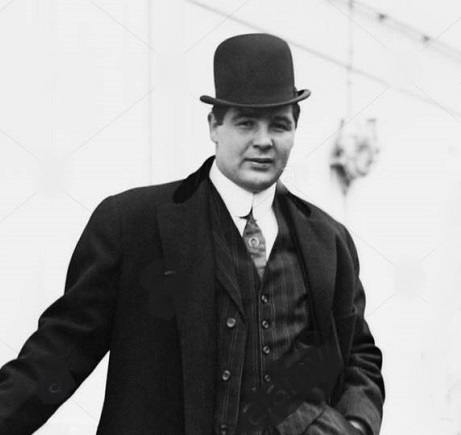Canada and USA
Meet Sam Berger, America’s First Olympic Heavyweight Champion

Meet Sam Berger – America’s first Olympic heavyweight champion was Sam Berger. In 1904, the first year that boxing was an Olympic sport, Berger, then 19 years old, defeated Charles Mayer to win the gold medal at the St. Louis games. Berger was an important figure on the American boxing scene in the first decade of the 20th century, but his gold medal should have been made of tin. By current standards, the 1904 event, which historians recognize as the third modern Olympics, was an Olympiad in name only.
The 2016 games that are now in progress in Rio de Janeiro pulled in 286 boxers from 76 nations. Contrastingly, only 22 boxers competed in the 1904 Olympics and they represented only one nation: the United States. In fact, as noted by the prominent freelance historian Evan Andrews, a compulsive list-maker, only 11 countries bothered to send athletes to the 1904 games.
The 1904 Olympiad was really nothing more than a sideshow to the St. Louis World’s Fair, otherwise known as the Louisiana Purchase Exposition. The Fair – the opening of which was pushed back a year because of construction delays – was conceived to commemorate the centennial of the Louisiana Purchase of 1803 which more than doubled the country’s land mass. The exposition, which was closed on Sundays, ran from April 30 to Dec. 1. The Olympic events began on July 1 and continued sporadically into the fall.
With only 22 boxers and seven weight divisions, it was inevitable that some weight classes, nay all weight classes, would be under-represented. The solution was to let some of the fighters double dip.
If there had been an Outstanding Boxer Award, it would have gone to a St. Louis man, Oliver Kirk, who finished first in the bantamweight and featherweight competitions. The man that Sam Berger defeated in the heavyweight finale, Charles Mayer, copped the gold medal in the middleweight class.
The boxing events had a strong San Francisco tone. Sam Berger was sponsored by San Francisco’s Olympic Club, the same club that gave Gentleman Jim Corbett his start. Three other gold medal winners, flyweight George Finnegan, lightweight Harry Spanjer, and welterweight Albert Young, came from San Francisco.
The San Francisco Bay Area was then America’s top destination for important prizefights and the amateur scene there was robust. San Francisco was a blue collar, hard drinking, hurly-burly town in those days, not the gentrified city that it would become. If San Francisco circa 1904 were a nation, one could say that prizefighting was her national sport.
How good was Sam Berger? Suffice it to say that on a list of former Olympic heavyweight champions, the likes of which include Joe Frazier, George Foreman, and Teofilo Stevenson, Sam Berger is an awkward fit. As a professional, he is credited with having only nine pro fights, of which he won five. Three of those bouts took place before he went off to St. Louis to compete in the Olympics. (While these three bouts were ostensibly amateur, researchers would find that Berger was down for a piece of the gate.)
The highlight of Berger’s brief pro career was his 6-round fight at Philadelphia with the city’s fistic star, Philadelphia Jack O’Brien. By law, no decision could be rendered, but Berger acquitted himself so well against the vastly more experienced O’Brien that he improved his stock enormously. But in his very next start, in what would be his final fight, he gave a poor performance against Al Kaufman who stopped him in the 10th frame.
Sam Berger, who won recognition as the amateur heavyweight champion of the west coast at the tender age of 17, flamed out early. But Berger remained an important cog in the national prizefighting apparatus through his relationship with James J. Jeffries.
After retiring as the undefeated heavyweight champion, Big Jim Jeffries became the highest paid attraction on the vaudeville circuit. Berger travelled with him, managing his day-to-day affairs and often playing Jim’s foil in public sparring sessions. Berger’s role continued when Jim left the stage to prepare for his ill-fated comeback fight with Jack Johnson, the first true Fight of the Century. Berger was Jeffries training camp coordinator. Berger also dabbled in the promotional side of boxing, refereeing most of the fights that he arranged, and had an interest in a high-end men’s clothing store run by his two brothers, Nat and Maurice.
The truth about Sam Berger was that he was always a better businessman than a boxer and that he lost the drive to succeed at boxing when the profits rolled in from other enterprises. He died at age 40 after a long, unspecified illness. According to newspaper reports, he left an estate of $100,000 (approximately $1.4 million in today’s dollars).
Meet Sam Berger
-

 Featured Articles4 weeks ago
Featured Articles4 weeks agoThe Hauser Report: Zayas-Garcia, Pacquiao, Usyk, and the NYSAC
-

 Featured Articles3 weeks ago
Featured Articles3 weeks agoOscar Duarte and Regis Prograis Prevail on an Action-Packed Fight Card in Chicago
-

 Featured Articles2 weeks ago
Featured Articles2 weeks agoThe Hauser Report: Cinematic and Literary Notes
-

 Book Review2 weeks ago
Book Review2 weeks agoMark Kriegel’s New Book About Mike Tyson is a Must-Read
-

 Featured Articles4 weeks ago
Featured Articles4 weeks agoRemembering Dwight Muhammad Qawi (1953-2025) and his Triumphant Return to Prison
-

 Featured Articles3 days ago
Featured Articles3 days agoThe Hauser Report: Debunking Two Myths and Other Notes
-

 Featured Articles1 week ago
Featured Articles1 week agoMoses Itauma Continues his Rapid Rise; Steamrolls Dillian Whyte in Riyadh
-

 Featured Articles3 weeks ago
Featured Articles3 weeks agoRahaman Ali (1943-2025)















